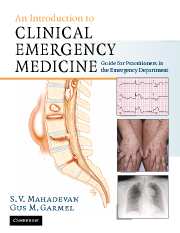Book contents
- Frontmatter
- Contents
- List of contributors
- Foreword
- Acknowledgments
- Dedication
- Section 1 Principles of Emergency Medicine
- Section 2 Primary Complaints
- 9 Abdominal pain
- 10 Abnormal behavior
- 11 Allergic reactions and anaphylactic syndromes
- 12 Altered mental status
- 13 Chest pain
- 14 Constipation
- 15 Crying and irritability
- 16 Diabetes-related emergencies
- 17 Diarrhea
- 18 Dizziness and vertigo
- 19 Ear pain, nosebleed and throat pain (ENT)
- 20 Extremity trauma
- 21 Eye pain, redness and visual loss
- 22 Fever in adults
- 23 Fever in children
- 24 Gastrointestinal bleeding
- 25 Headache
- 26 Hypertensive urgencies and emergencies
- 27 Joint pain
- 28 Low back pain
- 29 Pelvic pain
- 30 Rash
- 31 Scrotal pain
- 32 Seizures
- 33 Shortness of breath in adults
- 34 Shortness of breath in children
- 35 Syncope
- 36 Toxicologic emergencies
- 37 Urinary-related complaints
- 38 Vaginal bleeding
- 39 Vomiting
- 40 Weakness
- Section 3 Unique Issues in Emergency Medicine
- Section 4 Appendices
- Index
27 - Joint pain
Published online by Cambridge University Press: 27 October 2009
- Frontmatter
- Contents
- List of contributors
- Foreword
- Acknowledgments
- Dedication
- Section 1 Principles of Emergency Medicine
- Section 2 Primary Complaints
- 9 Abdominal pain
- 10 Abnormal behavior
- 11 Allergic reactions and anaphylactic syndromes
- 12 Altered mental status
- 13 Chest pain
- 14 Constipation
- 15 Crying and irritability
- 16 Diabetes-related emergencies
- 17 Diarrhea
- 18 Dizziness and vertigo
- 19 Ear pain, nosebleed and throat pain (ENT)
- 20 Extremity trauma
- 21 Eye pain, redness and visual loss
- 22 Fever in adults
- 23 Fever in children
- 24 Gastrointestinal bleeding
- 25 Headache
- 26 Hypertensive urgencies and emergencies
- 27 Joint pain
- 28 Low back pain
- 29 Pelvic pain
- 30 Rash
- 31 Scrotal pain
- 32 Seizures
- 33 Shortness of breath in adults
- 34 Shortness of breath in children
- 35 Syncope
- 36 Toxicologic emergencies
- 37 Urinary-related complaints
- 38 Vaginal bleeding
- 39 Vomiting
- 40 Weakness
- Section 3 Unique Issues in Emergency Medicine
- Section 4 Appendices
- Index
Summary
Scope of the problem
Non-traumatic joint pain is a common presenting complaint for patients in the emergency department, and emergency medicine practitioners should be knowledgeable in the evaluation of the “red hot joint.” While rarely life-threatening, joint pain is important because it may be the harbinger of more serious systemic diseases and infections. Furthermore, even mild diseases of many joints, especially the hands and weight-bearing joints, can result in significant short- and long-term disability. Accurate evaluation and treatment may reduce the severity and duration of disability.
Anatomic essentials
In order to determine the cause of joint pain, one must understand the underlying anatomy of the joint (Figure 27.1). The sources of joint pain may be classified into two major anatomic categories: articular structures (joint capsule and its contents) and periarticular structures (structures superficial to the joint capsule).
A joint is the union of the ends of two or more bones. On each bony surface lies a cushion, the articular cartilage, a compressible matrix of collagen fibers and proteoglycans which serves to prevent bone-on-bone contact. Adherent along the margins of the articular cartilage is a synovial membrane, which creates the synovial cavity. The synovial membrane also secretes high-viscosity synovial fluid, which fills the synovial cavity in order to lubricate the joints and facilitate mobility. A fibrous joint capsule encloses the synovial membrane, thus creating the unit known as the joint space.
The joint is strengthened and supported by ligaments, which are bands of fibrous tissues connecting bones or cartilages.
- Type
- Chapter
- Information
- An Introduction to Clinical Emergency MedicineGuide for Practitioners in the Emergency Department, pp. 401 - 412Publisher: Cambridge University PressPrint publication year: 2005



